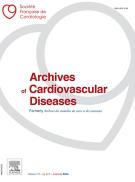Koch's triangle and coronary sinus anatomy assessed by three-dimensional electroanatomical mapping in paediatric patients with junctional tachycardia - 04/04/25

Graphical abstract |
Highlights |
• | 3D EAM is increasingly used in paediatric patients to reduce radiation exposure. |
• | Previous studies have suggested anatomical differences between AVNRT and AVRT. |
• | 3D EAM did not reveal significant differences in Koch's triangle or coronary sinus anatomy. |
• | Current 3D mapping systems may not depict complex intracardiac anatomy accurately enough. |
• | Traditional electrophysiological manoeuvrers remain essential for accurate diagnosis. |
• | Future improvements are needed to enhance intracardiac cardiac anatomy rendering. |
Abstract |
Background |
Three-dimensional electroanatomical mapping has become an essential tool in paediatric electrophysiology to precisely identify areas involved in arrhythmias. Anatomical variations in Koch's triangle, especially fluoroscopic enlargement of the coronary sinus ostium, have been found more frequently in patients with atrioventricular nodal reentrant tachycardia (AVNRT) than in those with atrioventricular reentrant tachycardia (AVRT). This finding is consistent with easier coronary sinus cannulation during electrophysiology procedures in patients with AVNRT.
Aim |
To explore anatomical differences in the coronary sinus and Koch's triangle between children with AVNRT and AVRT using three-dimensional system acquisitions.
Methods |
We conducted a single-centre retrospective study of paediatric patients undergoing a catheter ablation procedure for AVNRT or AVRT. Detailed anatomy of the coronary sinus ostium, global morphology and Koch's triangle properties was assessed via catheter-based intracardiac three-dimensional electroanatomical mapping, and compared.
Results |
Forty-four children were enrolled (22 in each group). The median age was 14.6 (interquartile range [IQR] 10.9–16.2) years. The coronary sinus ostium area and diameter were similar in the AVNRT and AVRT groups: area, 1.0 (IQR 0.7–1.2) vs. 1.2 (IQR 0.5–1.6) cm/m2, respectively (P=0.71; 95% confidence interval of median difference –0.3 to 0.3); diameter, 1.0 (IQR 0.8–1.5) vs. 1.1 (IQR 0.9–1.4) cm/m2, respectively (P=0.56; 95% confidence interval of median difference –0.2 to 0.2). Five patients (22.7%) in each group had a coronary sinus with a windsock morphology. There was no difference in the Koch's triangle area between the AVNRT and AVRT groups: 1.4 (IQR 1.1–2.0) vs. 1.6 (IQR 1.3–1.9) cm2/m2, respectively (P=0.37; 95% CI of median difference –0.2 to 0.5).
Conclusions |
Our findings suggest no difference in coronary sinus anatomy between these two junctional tachycardias. A potential explanation is the limited ability of three-dimensional mapping technologies to accurately define complex intracardiac structures.
Le texte complet de cet article est disponible en PDF.Keywords : Paediatric electrophysiology, Catheter ablation, Atrioventricular nodal reentrant tachycardia, Accessory pathway, Coronary sinus
Plan
| ☆ | X post (Tweet): New study shows no significant anatomical differences in Koch's triangle and coronary sinus between pediatric AVNRT and AVRT cases using 3D electroanatomical mapping. Challenges in mapping complex intracardiac structures may explain findings. #PediatricElectrophysiology #Cardiology. |
Vol 118 - N° 4
P. 260-267 - avril 2025 Retour au numéroBienvenue sur EM-consulte, la référence des professionnels de santé.
L’accès au texte intégral de cet article nécessite un abonnement.
Déjà abonné à cette revue ?

